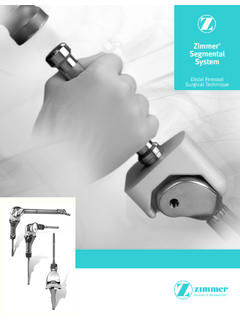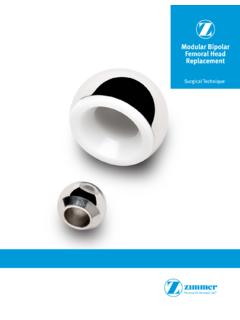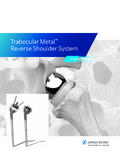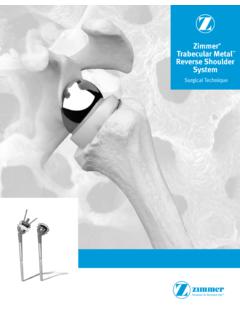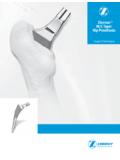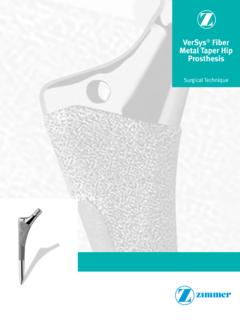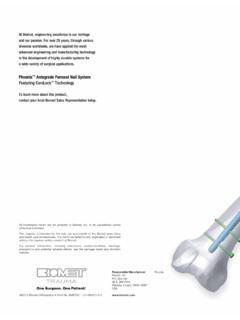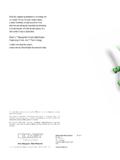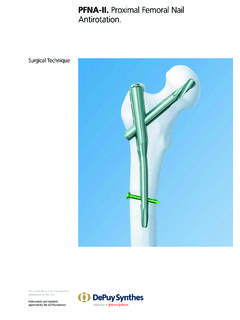Transcription of Zimmer Natural Nail System - Hip | Knee
1 Zimmer Natural nail SystemCephalomedullary NailSurgical TechniqueSTANDARDZ immer Natural nail System Cephalomedullary nail Surgical Technique - Standard1 Zimmer Natural nail System Cephalomedullary nail Surgical Technique - StandardTable of ContentsProduct Overview 2 Implant Overview 2 Indications 2 Contraindications 2 Surgical Technique 2 Preoperative Planning 2 Patient Positioning 2 Reduction 3 Starting Point Location 3 Proximal Reaming 4 Shaft Reaming 5 Implant Selection 5 nail Assembly and Insertion 5 Lag Screw Placement 7 Distal Targeting For Short Nails 10 Freehand Technique for Long Nails 11 Final Implant Placement 11 Postoperative Care 11 nail Extraction 11 Cephalomedullary Long nail Details 13 Cephalomedullary Short nail Details 14 Product Information 15 Zimmer Natural nail System Cephalomedullary nail Surgical Technique - Standard2 Product OverviewThe Zimmer Natural nail System is a System of intramedullary nails, screws, instruments and other associated implants that are designed to provide stable internal fixation for fractured long bones.
2 The nails have been designed for specific applications to help restore the shape of the fractured bone to its Natural , pre-injured state. The Cephalomedullary nail was designed to help treat fractures of the femur, especially intertrochanteric and subtrochanteric fractures. The nail features a small proximal section that is designed to minimize the amount of bone that must be removed for nail insertion. A lag screw is placed through the nail into the femoral head to secure the nail in place proximally and help control the different segments of the bone while healing occurs. Screws are placed through the nail distally to further secure the implant in place and maintain length and alignment while healing occurs.
3 A choice of short and long nails, as well as nails of different diameters and center-column-diaphyseal (CCD) angles are available to best match the individual anatomy of the OverviewNail Diameters: 10, , 13, ( is available only for short nails) nail Lengths: (short), 30 to 48cm in 2cm incrementsCCD Angles: 125 , 130 , 135 Lag Screw Diameter: Screw Lengths: 70 to 130mm in 5mm incrementsDistal Screw Diameter: Screw Lengths: 20 to 60mm in increments, 65 to 100mm in 5mm incrementsDistal Screws available in fully- and partially-threaded configurationsMaterials: Ti-6Al-4V alloyPrecision instrumentation is provided to help implant the nail .
4 Many of the instruments and implants feature a color coding System to help the surgical team use the System . Certain instruments are not color coded. The color coding System is referenced in the technique. A wall chart (97-2493-003-00) is also available to help explain the color coding Zimmer Natural nail System is intended for temoraty fracture fixation and stabilization of the for the Cephalomedullary nails include: Compound and simple shaft fractures Proximal, metaphyseal and distal shaft fractures Segmental fractures Comminuted fractures Fractures involving osteopenic and osteoporotic bone Pathological fractures Fractures with bone loss Pseudoarthrosis, non-union, mal-union and delayed union Periprosthetic fractures Surgically created defects such as osteotomies Intertrochanteric and subtrochanteric fracturesContraindications A medullary canal obliterated by a previous fracture or tumor Bone shaft having excessive bow or deformity Lack of bone substance or bone quality.
5 Which makes stable seating of the implant impossible All concomitant diseases that can impair the functioning and the success of the implant Infection Insufficient blood circulation Skeletally immature patientsWARNING: This nail should only be used to treat a periprosthetic fracture if the in situ device is firmly fixed. When treating a periprosthetic fracture, the nail should be positioned so that it does not come in contact with the in situ device. Surgical TechniquePreoperative PlanningPreoperative planning is recommended before beginning the surgical procedure. An A/P and lateral x-ray of the injured femur should be taken preoperatively and evaluated for length, canal size and implant suitability.
6 A/P and lateral x-rays of the contralateral uninjured femur can also be taken preoperatively to provide insight into the characteristics of the pre-injured femur. Zimmer Natural nail System Cephalomedullary nail Surgical Technique - Standard3 Patient PositioningPatients can be positioned either supine or in a lateral decubitus position. As the C-arm will be used during the procedure, care should be taken to orient the patient to allow for A/P and lateral imaging of the proximal femur, the fracture and the distal femur. The use of a fracture table can be beneficial in helping to reduce fractures as well as to facilitate intraoperative imaging with a C-arm.
7 The patient should be positioned to allow for easy access to the greater trochanter of the femur with instrumentation. Adduction of the affected leg can also be helpful, especially in the supine the patient appropriately to allow the surgeon to work around the hip and full length of the femur (to the knee).ReductionIt is critical to achieve anatomic reduction before beginning any of the steps to place the intramedullary nail . Traction should be used as necessary to help achieve fracture reduction. Several instruments are available to assist in fracture reduction including clamps, ball spike pushers and Steinmann Point LocationPalpate the greater trochanter manually.
8 Incise the skin starting about 2 cm proximal to the tip of the greater trochanter and extending proximally 2 to 3 cm. Dissect through the tissues splitting the fascia lata down to the bone. Assemble the STARTING POINT LOCATOR inside the ENTRY CANNULA. Place the tip of the STARTING POINT LOCATOR through the incision down to the tip of the greater trochanter (Fig. 1).In large patients and/or when using the standard guide, a more proximal incision may be the PIN through the center hole of the STARTING POINT LOCATOR. Use the C-arm to visualize the pin s position from an A/P and lateral view. The pin should be inserted at the tip of the greater trochanter in the posterior portion of the middle third of the trochanter.
9 The pin should not be on the lateral portion of the greater trochanter, it must be on the tip. A starting point slightly medial to the tip of the trochanter is also acceptable. NOTE: A starting point lateral to the tip of the greater trochanter may lead to a varus reduction following nail insertion. If necessary, remove the pin and move it into the hole in the STARTING POINT LOCATOR that will align the pin correctly with the tip of the greater the pin through the tip of the greater trochanter down to the level of the lesser trochanter. Remove the STARTING POINT LOCATOR from the ENTRY CANNULA. Use the 8mm ENTRY REAMER to ream an entry portal into the proximal femur through the starting point on the tip of the greater trochanter (Fig 2).
10 Remove the reamer and 1 Alternatively, a CANNULATED AWL can be used to find the entry point and create the entry portal (Fig. 3). Widening of the fracture side and varus tilting of the proximal fragment should be 2 Fig. 3 Zimmer Natural nail System Cephalomedullary nail Surgical Technique - Standard4A REDUCTION FINGER is included in the set. The ball tip guide wire can be fed retrograde through the REDUCTION FINGER. The REDUCTION FINGER can then be placed into the femur and used to help reduce the femur from the inside as well as to help facilitate passage of the guide wire past the fracture a LONG nail is to be implanted, assemble the Two Piece nail LENGTH GAUGE.

